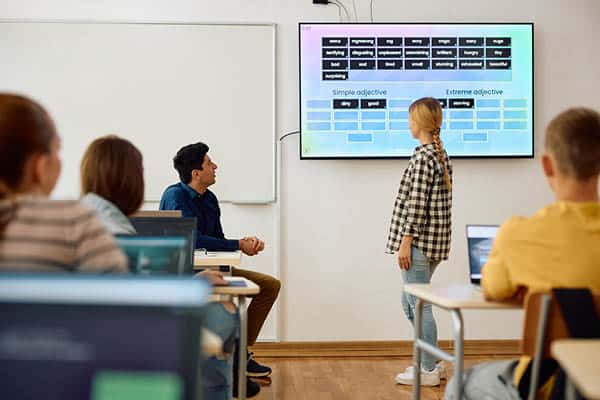The positive impact is huge with continuous developments. But some potential negatives must be monitored and managed. eSchool News cites 9 positive benefits of edtech innovation and 5 possible downsides:
- More learning opportunities: Technology provides access to a vast array of educational resources, including online texts, interactive simulations, and multimedia content. This diversification of learning materials caters to different learning styles, fostering a more inclusive and engaging educational environment.
- Personalized learning: Adaptive learning platforms and educational software leverage technology to tailor lessons based on individual student needs. This personalized approach allows students to progress at their own pace, reinforcing understanding and addressing specific learning gaps.
- More–and better–student engagement: Interactive whiteboards, educational games, and multimedia presentations capture students’ attention and make learning more enjoyable. Increased engagement can lead to better retention of information and a more positive attitude toward learning.
- Collaborative learning: Technology facilitates collaboration among students, both within and beyond the classroom. Online collaborative tools, virtual classrooms, and shared documents enable students to work together on projects, promoting teamwork and communication skills.
- Enhanced educator efficiency: Edtech streamlines administrative tasks for teachers, allowing them to focus more on instruction and individual student needs. Learning management systems (LMS) and grading software automate routine tasks, saving time and improving efficiency.
- Preparation for the digital age: Integrating technology into K-12 education helps students develop digital literacy skills essential for the modern workforce. Familiarity with various digital tools and platforms prepares students for the technological demands of the 21st century.
- More access to remote learning: Technology enables remote learning opportunities, offering flexibility for students who may face geographical or scheduling constraints. This proved especially crucial during times of disruptions, such as the COVID-19 pandemic, allowing education to continue remotely. And post-COVID, many districts have kept solid remote learning options in place for students who need them.
- Data-driven decision making: Educators can use edtech tools to gather and analyze data on student performance. This data-driven approach allows teachers to identify areas for improvement, customize instruction to individual needs, and make informed decisions about educational strategies.
- Inclusive education: Technology supports inclusive education by providing assistive tools for students with diverse learning needs. These tools can include text-to-speech software, screen readers, and other assistive technologies that enhance accessibility. Students with unique and special needs can better access learning opportunities.
But along with these positive edtech updates, it’s important to acknowledge there are several potential negative impacts:
- The digital divide: Not all students have equal access to technology, leading to a digital divide. Students from lower-income families or rural areas may lack access to devices and reliable high-speed internet, exacerbating educational inequalities.
- Overreliance on screens: Excessive screen time can contribute to issues like eye strain, fatigue, and potential negative effects on physical health. Balancing screen-based learning with other instructional methods is critical to students’ overall well-being.
- Distraction and lack of focus: The presence of devices in classrooms can lead to distractions, with students potentially engaging in non-educational activities during lessons. Maintaining students’ focus becomes a challenge in technology-rich environments.
- Privacy and security concerns: The use of online platforms and educational apps raises concerns about the privacy and security of students’ personal information. Ensuring protection of sensitive data is a priority, and schools must ensure robust security measures.
- Potential for misuse: Students may misuse technology for non-educational purposes, engaging in activities like online bullying, cheating, or accessing inappropriate content. Schools need to implement policies to address these issues.
Addressing these potential negative impacts requires careful planning, ongoing assessment, and developing policies that prioritize both the benefits and challenges associated with technology in K-12 education.
eSchool News





